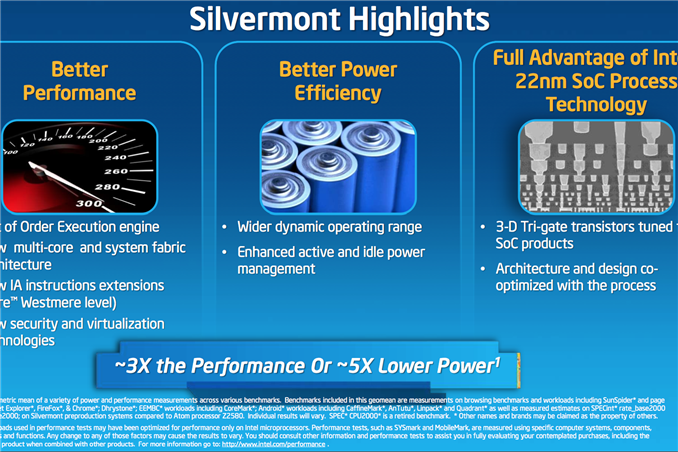Saltwell core, PowerVR SGX xxx,1.x++ GHz
http://www.intel.com/content/www/us/en/sma...martphones.html
http://en.wikipedia.org/wiki/Atom_(system_on_chip)
QUOTE
In 2012, Intel expanded the Atom processor family with a new system on chip (SoC) platform designed for smartphones and tablets.[1] It is a continuation of the partnership announced by Intel and Google on 13 September 2011, to provide support for the Android operating system on Intel x86 processors.[2]
Atom competes with existing SoCs developed for the smartphone and tablet market from companies like Texas instruments, Nvidia, Qualcomm and Samsung.[3] Unlike these companies, which use ARM-based CPUs designed from the beginning to consume very low power, Intel has adapted the x86 based Atom line CPU developed for low power usage in netbooks, to even lower power usage.
In April 2012, several manufacturers have released Intel Atom-based phones; as a result of testing industry reviewers came to conclusion that Atom SoC-based smartphones can compete both power-wise and performance-wise with currently dominating ARM-based smartphones
Atom competes with existing SoCs developed for the smartphone and tablet market from companies like Texas instruments, Nvidia, Qualcomm and Samsung.[3] Unlike these companies, which use ARM-based CPUs designed from the beginning to consume very low power, Intel has adapted the x86 based Atom line CPU developed for low power usage in netbooks, to even lower power usage.
In April 2012, several manufacturers have released Intel Atom-based phones; as a result of testing industry reviewers came to conclusion that Atom SoC-based smartphones can compete both power-wise and performance-wise with currently dominating ARM-based smartphones
Asus Fonepad Note FHD 6
Asus MeMO Pad FHD 10
Samsung GT-P5200 Galaxy Tab 3 10.1
Lenovo K900
Asus FonePad ME371MG
Acer Liquid C1
Lenovo K800
Motorola RAZR i XT890
Lava Xolo X1000
http://en.wikipedia.org/wiki/Android-x86
QUOTE
Android-IA
A derivation of the project, Android-IA[2] has been produced by Intel.[3] The project states that its intention is to port Android on to x86-based mobile platforms, such as the Intel Medfield architecture.
A derivation of the project, Android-IA[2] has been produced by Intel.[3] The project states that its intention is to port Android on to x86-based mobile platforms, such as the Intel Medfield architecture.
Sos:http://www.intel.my/content/www/us/en/smar...martphones.html
http://pdadb.net/index.php?m=cpu&id=i2560z...ntel_atom_z2560
http://pdadb.net/index.php?m=pdamaster&posted=1&cpu=i2580z
http://pdadb.net/index.php?m=pdamaster&posted=1&cpu=i2480z
http://pdadb.net/index.php?m=pdamaster&posted=1&cpu=i2460z
http://pdadb.net/index.php?m=pdamaster&posted=1&cpu=i2420z
Atom (system on chip)
http://en.wikipedia.org/wiki/Atom_(system_on_chip)
http://www.theverge.com/2012/2/27/2828158/...admap-14nm-2014
http://www.maximumpc.com/article/news/inte...atom_processors
http://pc.watch.impress.co.jp/docs/column/...806_307443.html
http://en.wikipedia.org/wiki/List_of_Intel...roarchitectures
Smartphone/Tablet processor Teread;War begain;, [Atom],Krait,Tegra4,Exynos5,A9600,OMAP5
http://forum.lowyat.net/index.php?showtopic=2751654&hl=
Older device that using Intel Processor
Mobile Internet device
http://en.wikipedia.org/wiki/Mobile_Internet_device
Update
QUOTE
The Bay Trail Preview: Intel Atom Z3770 Tested
http://www.anandtech.com/show/7314/intel-b...om-z3770-tested
Bay Trail & Branding

Bay Trail, like all Atom platforms before it, will be available in multiple form factors. Unlike the Atoms of yesterday however, the SoC will carry Pentium and Celeron branding when used in notebooks and desktops. Intel didn’t disclose too much about its Silvermont plans in other form factors other than some basic naming:
Basically notebooks ship under the Pentium N3000 & Celeron N2000 series, while desktops will carry Pentium J2000 & Celeron J1000 branding. All Pentium SKUs seem to be quad-core, while Celeron SKUs will be available in both dual and quad-core versions.
Thankfully Intel shied away from introducing the same complexity with its tablet focused Bay Trail parts. All Bay Trail tablet SKUs carry Atom branding. There’s the quad-core Z3700 series and the dual-core Z3600 series.
http://www.anandtech.com/show/7314/intel-b...om-z3770-tested
Bay Trail & Branding

Bay Trail, like all Atom platforms before it, will be available in multiple form factors. Unlike the Atoms of yesterday however, the SoC will carry Pentium and Celeron branding when used in notebooks and desktops. Intel didn’t disclose too much about its Silvermont plans in other form factors other than some basic naming:
Basically notebooks ship under the Pentium N3000 & Celeron N2000 series, while desktops will carry Pentium J2000 & Celeron J1000 branding. All Pentium SKUs seem to be quad-core, while Celeron SKUs will be available in both dual and quad-core versions.
Thankfully Intel shied away from introducing the same complexity with its tablet focused Bay Trail parts. All Bay Trail tablet SKUs carry Atom branding. There’s the quad-core Z3700 series and the dual-core Z3600 series.








This post has been edited by wkkm007: Sep 18 2013, 08:28 PM


 Mar 28 2013, 03:25 AM, updated 13y ago
Mar 28 2013, 03:25 AM, updated 13y ago
 Quote
Quote


 0.0262sec
0.0262sec
 0.74
0.74
 5 queries
5 queries
 GZIP Disabled
GZIP Disabled